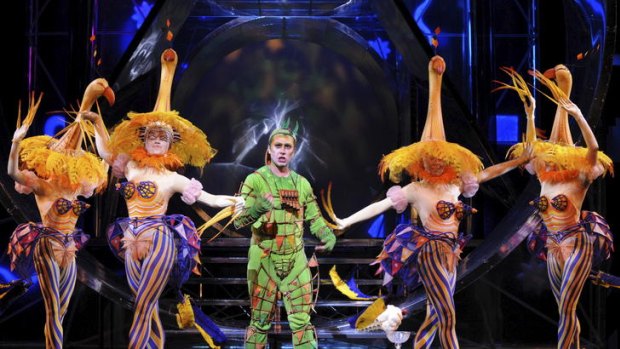By Robin Usher
IT IS rare for opera practitioners to criticise any elements of the art form but Opera Australia's artistic director, Lyndon Terracini, does not hold back about one of the staples of the repertoire, Mozart's The Magic Flute.
''Mozart never intended it to be seen as an opera,'' he says. ''It is a singspiel that was created for a suburban audience away from the Viennese court. I think the work is burdened when it is treated as an opera and it can easily become pompous, especially in the second half.''

Andrew Jones (centre) as Papageno in Opera Australia's production of The Magic Flute. The work contains riddles that have intrigued people for centuries.
The company's new Flute production is based on a version by New York's Metropolitan Opera that is sung in English and has been edited to suit what Terracini says was the aims of its creators, Mozart and the librettist and theatre operator Emanuel Schikaneder.
It was directed by Julie Taymor of The Lion King fame - and later Broadway's most expensive production, Spider-Man: Turn off the Dark - and features dazzling costumes, special effects and an array of puppets and props. It has been described as The Lion King with better music. Set designer George Tsypin also worked with Taymor on Spider-Man.
The puppets include a nine-metre serpent made of silk that will be manoeuvred by nine puppeteers as it moves around the State Theatre stage. There will also be a giant goose ''flying'' 4.5 metres above the ground, balanced by two performers in harnesses, beautiful hand-painted and wire-framed birds, several polar bears, and other assorted animals, all of them made in Australia.
The show was very successful in Sydney, exceeding its budget by selling about 36,000 tickets for a return of $4.5 million. Nearly 4500, or 12 per cent, were youth subscribers, students and children.
''The audience responded, which fits our philosophy of attracting as many people as possible,'' Terracini says. ''A large audience means we can be more adventurous in programming the rest of the season. But it doesn't mean we won't mount a full version of The Magic Flute ever again.''
OA's resident producer, Matthew Barclay, is responsible for mounting the show in Australia, adjusting it after the Sydney Opera House season for the bigger State Theatre stage, which is still smaller than the New York original.
''The Met doesn't often license one of their productions without any direct involvement,'' Barclay says. ''This production is based on the Julie Taymor original and we have the freedom to bring it to life with the same sense of theatricality.''
The dancers have been reduced from 24 to 14, but all the effects are retained. ''Perhaps we have been more inventive than the Met because we don't have the ability to throw money at something to make it work.''
The show's costumes and make-up originated in Florence in 1993, when Taymor first explored the idea of the set of a crystalline temple floating in space. This was further developed at the Met in 2004 and when Taymor had the idea of taking it to Broadway, the company decided to present a cut-down summer show for children two years later.
''Julie Taymor is a unique theatre practitioner,'' Barclay says. ''She calls on the tradition of south-east Asian puppetry to produce works that are very visual and vibrant.''
He admires her ability to marry the profane in an entertaining slapstick with the profound theme of the original about children breaking the bonds of parents and state.
''It is a fairytale, so it needs to be light with a sense of play. The kids see a magic world that belongs to fairytale, not a physical or temporal setting.''
Thanks to the editing, he says, the focus is on the five main characters - the lovers Tamino and Pamina, Papageno and Papagena, and the high priest, Sarastro. ''It is aimed at kids and everyone knows how hard they are to please. The production has to be fast and seamless and the storytelling is freed from the dense subject matter to be easy to follow. It can be hard in the Flute to make a coherent whole with all the characters fitting into the same opera.''
The young characters go on a journey of growth. ''Tamino improves himself spiritually and Pamina undertakes a trial of fire and water. That is a long way from family entertainment.''
Barclay says the work remains timeless because it contains riddles that have intrigued people for centuries. But to answer them all makes it boring. ''It is much better to leave it mysterious with unanswered questions.''
The Magic Flute opens at the State Theatre next Saturday until May 12.